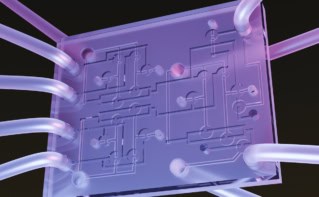
Is there an alternative to nanostructuring electrode materials to speed up ionic diffusion in lithium-ion batteries and so increase their maximum power output and charging rates? Yes, according to researchers at the University of Cambridge in the UK, who have shown that two complex niobium tungsten oxides can intercalate large amounts of lithium even when the oxides are microns in size. The new work will be important for developing systems that require high power delivery and/or fast charging (think of a mobile phone that could be fully charged in just minutes). It could also have implications for solid-state energy storage for example, in electric cars, and grid-scale storage for solar power.
Ubiquitous in portable electronics, rechargeable lithium-ion batteries consist of two electrodes – anode and cathode – separated by an electrolyte. When the battery is being charged with electrical energy, lithium ions move from the cathode through the electrolyte to the anode, where they are absorbed and stored into the bulk of the anode material.
The maximum power output and the rate at which these batteries can be charged and discharged is typically limited by solid-state ionic transport in the electrodes. To speed up ionic diffusion and so reach high power and rapid charging, the size of the active particles in the electrodes is often reduced to the nanoscale – so that the lithium ions have a shorter distance to travel. Nanoparticles are difficult to pack together, however, which affects the battery’s volumetric energy density. They are also difficult to process and can undergo unwanted chemical reactions with the electrolyte, so ultimately reducing battery life and increasing cost.
“Nanoscaling and nanostructuring are simply not needed”
A team of researchers led by Clare Grey has now found that two complex “block” or “bronze-like” niobium tungsten oxides (Nb16W5O55 and Nb18W16O93) can intercalate large quantities of lithium at high rates even when the particles are as big as 30 microns in size. Measurements of how lithium ions move through the materials (using a technique called pulse field gradient NMR) point to room-temperature diffusion rates that are several orders of magnitude higher than those in typical electrode materials such as Li4Ti5O12 and LiMn2O4. This rapid solid-state lithium transport in the bulk materials leads to extremely high volumetric capacities and rate performance so nanoscaling and nanostructuring are simply not needed, says study lead author Kent Griffith.
Most conventional negative electrodes in lithium-ion batteries are made of graphite, which has a high energy density, explains Grey. However, when charged at high rates, spindly lithium fibres known as dendrites form. These can create a short circuit and cause the batteries to catch fire, or even explode.
“In high-rate applications, safety is a bigger concern than under any other operating circumstances,” she says. “These materials and potentially others like them, would definitely be worth looking at for fast-charging applications where you need a safer alternative to graphite.”
“One of the most important aspects of our work is the discovery that energy storage material candidates with unconventional structures can boast exceptional performance,” Griffith tells Physics World. “This means that complex, relatively unexplored regions of composition/structure phase space may hold promise for next-generation devices. In particular, breaking away from the often-held belief that nanoscaling is mandatory to achieving high-rate storage may help the transition from new materials to applications.”
Higher densities at high discharge/charge rates
One of the reported niobium tungsten oxides is built from 4 x 5 blocks of (Nb,W)O6 octahedra that are connected along shear planes, he adds. The other, the “bronze-like” phase, is held open by pillars of oxygen that prop open the atomic layers. Both compounds are easily synthesized and allow lithium ions to quickly move through them in 3D. Their architectures also make them more rigid than other battery materials.
“They may be able to safely offer higher densities at high discharge/charge rates and could thus be used in systems requiring high power delivery and/or fast charging, possibly in combination with lower rate, high-energy-density batteries,” he says. The fact that they can readily be produced without any additional chemicals or solvents is another point in their favour.
The team, which includes researchers from the Advanced Photon Source at the Argonne National laboratory in the US and the Diamond Light Source in Didcot in the UK, says that it is now busy conducting further electrochemical tests on niobium tungsten oxides and optimizing them for specific applications. “We will also be applying the design principles and advanced characterization techniques employed in this work to unearth new material compositions and chemistries,” says Griffith.
The research is detailed in Nature 10.1038/s41586-018-0347-0.

Folded graphene boosts energy storage in lithium-ion batteries



